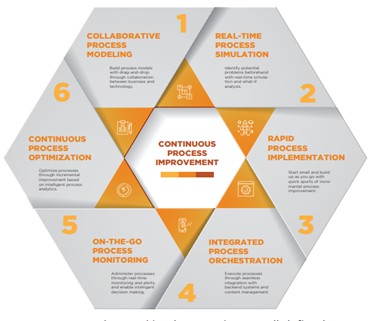The global digital process automation market is projected to hit the USD 12.61 billion mark by 2023.
Gartner explains that “hyperautomation is a business-driven, disciplined approach that organizations use to rapidly identify, vet, and automate as many business and IT processes as possible. The critical takeaways and benefits of hyperautomation are to develop a real-time end-to-end automated solution for business users It enables predictive insights, guided recommendations, process mining, and adaptive decision making by driving higher-level functionality ranging from task automation to orchestration to intelligence.
Hyperautomation introduces a set of advanced technologies that augment the human workforce and workflows far more effectively than isolated automation tools. The initiative is to lower operational costs and eliminate time-consuming, repetitive processes, that lead to human error and drastically reduce performance and scalability. Hyperautomation involves the orchestrated use of multiple automation technologies, tools, algorithms, bots, or platforms, including:
- Artificial Intelligence (AI)
- Machine Learning (ML)
- Event-driven software architecture
- Robotic Process Automation (RPA)
- Business Process Management (BPM)
- Intelligent Automation
- Natural Language Processing (NLP)
- Optical Character Recognition (OCR) and finally
- Digital Process Automation (DPA)
For hyperautomation to achieve its desired outcomes, an integrated approach with the right mix of the above-advanced technologies is vital.
With enterprises leveraging digital process automation (DPA) platforms at a rapid pace, it is important to understand what it stands to offer.
Here’s a list of benefits that you can achieve with a DPA platform.
1. Delivering a Superior Customer Experience
DPA platforms help you deliver a delightful customer experience by breaking the existing silos through end-to-end process automation and seamless information flow.
2. Driving Continuous Process Improvement
Driving process improvement is the need of the hour for businesses to stay relevant. DPA facilitates this with capabilities such as collaborative process modeling, real-time process simulation, rapid process implementation, integrated process orchestration, on-the-go process monitoring, and continuous process optimization.
Continuous Process Improvement Cycle

3. Leveraging New-age Capabilities
To stay current and ahead of your competition, you need to leverage new-age capabilities, such as robotic process automation, social, mobile, analytics, cloud, etc. A DPA platform helps you embrace all these technologies and more.
4. Modernizing Legacy Systems
Legacy systems exist, and we cannot do away with them easily. A digital process automation platform can help you modernize & streamline your legacy systems with RPA-based automation, low code capability, exception handling and case management capabilities, and others.
5. Creating a Connected Enterprise
DPA enables you to achieve a truly connected enterprise by integrating your business processes, systems, people, and things. This allows stakeholders, from suppliers to customers, to actively participate in business transactions and work anytime-anywhere within the supply chain.
6. Empowering Knowledge Workers
Digital process automation provides context to your knowledge workers with advanced analytics, empowering them to make informed decisions and execute tasks timely.
DPA platforms offer a host of benefits and can solve multiple use cases. Thus, while looking out for a DPA platform, it is essential to gain clarity as to what is your end goal and choose accordingly. Where are you in your digital transformation and hyperautomation journey?
In its evaluation of DPA vendors for “Forrester Wave: Digital Process Automation Software, Q4 2021,” Forrester has listed down 23 criteria that hold significant value for organizations.
Newgen has been named as a Strong Performer in Digital Process Automation Platforms.
You might be interested in



25 Sep, 2025
Transforming Enterprises with Newgen’s Business Process Management Software

